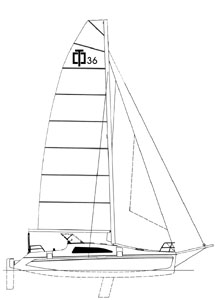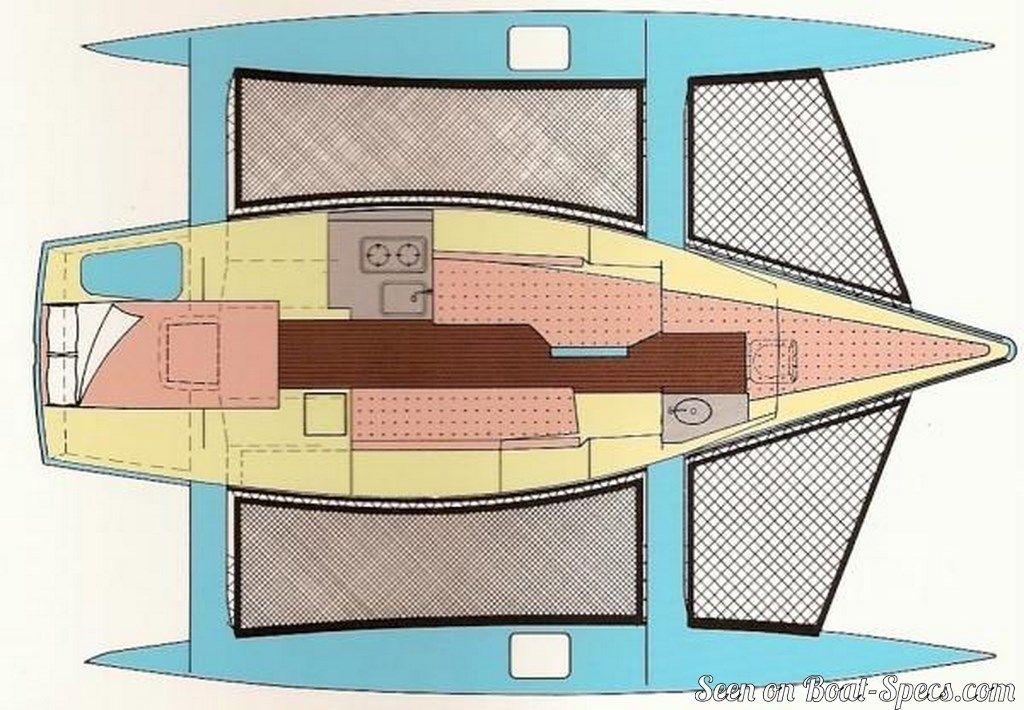First introduced in 1985, this trailerable trimaran quickly became a seminal boat in the world of multihull sailing. Designed by Ian Farrier, a Kiwi who emigrated to California (by way of Australia) with the specific goal of perfecting his concept of a production-built trimaran with folding amas, the F-27 is both an excellent high-performance coastal cruiser and a competitive one-design racing machine. During a 12-year production run that ended in 1997, a total of 453 hulls were launched, making this by far the most successful boat of its type to date. Arguably, the boat is still in production, as Corsair’s successor design, the F-28, though it has a rotating wing mast and is generally more sophisticated, is quite similar and is built with much of the same tooling.

The F-27 is certainly not a boat for anyone interested in roomy accommodations. Though the body of the main hull flares out a great deal above the waterline to maximize interior space, the layout and furnishings are cramped and strictly minimal. There is only sitting headroom, except under the pop-top roof near the companionway where the simple galley is located. Berthing is limited: in the tiny aft cabin there is a narrow double berth, there are two narrow settee berths in the saloon (separated by a small removable table), plus there’s a tiny berth suitable for a small child in the forepeak.
Corsair Marine was founded in 1984 by John Walton, the son of Sam Walton, founder of the retail giant Wal Mart. The shipyard from San Diego was engaged in the construction of sailing trimarans. Her first model was the Corsair F-27, developed by Ian Farrier.
Even a couple sailing alone on this boat will want to spend much of their time, weather permitting, hanging out in the cockpit or on the wide nets between the amas and the hull. As such, the F-27 serves best as a weekend cruiser with perhaps occasional stints aboard as long as a week or two. Though several of these boats have made ocean passages, they are not really suitable for long-range bluewater cruising unless you are something of a masochist.
Nicely finished saloon on a F-27
A less nicely finished saloon, but with the berths all filled in
- Manuals and User Guides for Corsair Marine F-28. We have 1 Corsair Marine F-28 manual available for free PDF download: Sailing Manual Corsair Marine F-28 Sailing Manual (47 pages).
- Apache Server at sailingmagazine.net Port 80.
- The load-carrying capacity of the different Corsair models is listed in the back of this manual. Some overloading is acceptable for general sailing in sheltered waters, the only adverse affect being a loss in performance. However, an overloaded boat offshore in large waves can become dangerous due to greater loads generated in the structure,.
The forepeak. The small single berth forward is rarely used as such, due to the close proximity of the toilet
The best way to expand living space aboard is to add a cockpit tent
What the F-27 lacks in amenities and comfort it makes up for in cruising range. Because it can be trailered, the boat can get to all sorts of places–inland lakes and distant shorelines, for example–that would otherwise be out of reach. And because it is so fast, it can cover a lot more ground than most boats once it is in the water. In a little speedster like this you can potentially travel over 100 miles during a long daysail. If you don’t really care about sailing fast and aren’t interested in taking advantage of this sort of capability, this is definitely not the boat for you. But if you want to both cruise and race, you should give the F-27 a hard look. Many people cruise these boats, and there is a very active one-design class.
Folded up and packed to travel on a trailer. You can easily expand your cruising range by simply hauling the boat to a new body of water
As originally conceived the F-27 carries no bowsprit and flies a conventional triangular (or “pinhead”) mainsail hoisted on a fixed aluminum mast. In 1996 a “formula” version of the boat was introduced with both a square-headed main that carries a lot more roach and a fixed bowsprit for flying a big screecher or asymmetric spinnaker. Many of the earlier boats have since been updated with formula rigs, as they are both faster and easier to manage.
On the whole, the boat is not hard to sail shorthanded. The self-draining cockpit is quite small with the mainsheet within immediate reach of the tiller, which extends from the transom over the top of the short aft coachroof and under the raised main traveler. Other controls, likewise, are right nearby. If anything, unless you can convince idlers to stay clear of the cockpit, the boat is harder to sail with a big crew.

There is a large central daggerboard to hold the boat to weather and unlike many multihulls the F-27 is rather closewinded and makes excellent progress to windward in light air. I once spent a delightful hour beating up a very narrow channel in an F-27 in a mere whisper of breeze and had no trouble maintaining apparent wind angles of 40 degrees. In a moderate breeze the boat points as high as 35 degrees apparent and chugs along at 8 knots no problem. With the wind on the beam, if you press hard with a spinnaker up, you can get up to 20 knots, which is a thrill and a half in a vessel this size.
If there are kids aboard and you don’t want to terrify them, just douse the headsail and the boat still sails well under main alone. Or stash them all in the aft cabin where you can keep an eye on them while steering and let it rip anyway.
A formula-rigged F-27 sailing to windward


Here’s one way to carry a tender while cruising on an F-27
The F-27’s construction is structurally impeccable and thoroughly modern. The S-glass laminate is set in epoxy resin with a PVC foam core to reduce weight and increase stiffness. Kevlar and carbon fiber are used to reinforce high-load areas, and all components are vacuum-bagged when laid up so as to minimize voids and achieve uniform resin saturation. The patented folding ama arms are well engineered, with few if any reports of failures or problems. The amas can be folded up while motoring through the water, which is a great convenience when pulling into a marina berth. When launching the boat from a trailer it takes about 30 minutes for an experienced owner to step the mast and set up the rig without assistance. Because they are so well built these boats are not cheap given their size, but if you factor in the savings realized from being able to store the boat on a trailer, they are in fact quite affordable over the long run.
Corsair F 27 Sailing Manual Yamaha
Systems are primitive and therefore are easy and inexpensive to maintain. Auxiliary power consists of an 8 or 9 hp outboard engine hanging in an offset engine well at the stern. The stove is usually a simple two-burner non-pressurized alcohol rig; the ice box (never mind any kind of refrigeration) is a loose cooler dragged aboard and stowed in a convenient nook or cranny. The boat has a 12-volt electrical system powering a few lights and instruments and probably requires some extracurricular charging from a solar panel or two if used very much. The toilet is often nothing more than a porta-potty stashed under the forward berth. To those who value comfort and convenience all this no doubt sounds unpleasant, but to those who enjoy sailing fast and cherish simplicity it should seem like heaven afloat.
Corsair 27 Sailboat
Specifications
Corsair 27 For Sale
LOA: 27’1″
LWL: 26’3″
Beam
-Amas extended: 19’1″
-Amas folded: 8’5″
Draft
-Board up: 1’2″
-Board down: 4’11”
Displacement
-Light ship: 2,600 lbs.
-With maximum payload: 3,800 lbs.
Sail area
-Original rig: 446 sq.ft.
-Formula rig: 502 sq.ft.
Fuel: 6 gal.
Water: 14 gal.
D/L ratio
-Light ship: 64
-With maximum payload: 94
SA/D ratio
-Original rig/Light ship: 37.69
-Original rig/Max load: 29.26
-Formula rig/Light ship: 42.42
-Formula rig/Max load: 32.93
Nominal hull speed
-Light ship: 11.6 knots
-With maximum payload: 10.3 knots
Typical asking prices: $35K – $50K